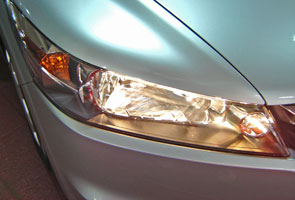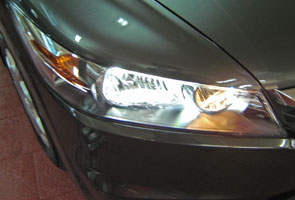LTA guidelines on installation of aftermarket headlights
01 Sep 2007|81,938 views
 |  |
| Halogen vs High Intensity Discharge (HID) Headlight, which one do you prefer? | |
The Land Transport Authority (LTA) requires all designs of vehicle lights to comply with the Road Traffic (Motor Vehicles, Lighting) Rules. All vehicle lights must comply with internationally recognized standards, such as those adopted in the European Union countries, Japan and the United States. The lights must conform to the stipulated illuminated color and intensity.
For headlights, the LTA requires every unit fitted on the vehicle to be capable of casting a visible light to the front of the vehicle. The intensity and alignment of a headlight must be within the specified limits. Besides HID lamps, halogen bulbs with whiter light are also allowed. These bulbs are designed to filter out the yellowish spectrum, hence emitting a whiter light which increases visibility at night. Bulbs should not exceed the recommended wattage rating by the vehicle manufacturer. After the bulb replacements, the headlights should be properly aligned to prevent its glare from distracting other road users.
Unless it is duly certified by the vehicle manufacturers, LTA usually does not allow the retrofitting of HID lamps on existing vehicles. Usually, due to the different reflectors and lenses used, the whole headlight assembly will have to be replaced during the switch to HID lamps. The wiring of the headlight system will need to be changed as a higher starting current is required for the HID lamps. This may cause extensive damage to the system and pose a fire hazard to both the driver and the public.
For some new vehicles with factory-fitted HID headlight systems, vehicle manufacturers have incorporated an auto altering or levelling feature. This feature will automatically adjust the headlight angle and direction based on road and driving conditions to minimise glare. Some vehicle manufacturers are also attempting to reduce glare by changing the constitution of the glass used in the vehicle's headlights, windshields, and windows.
Do check with the relevant vehicle manufacturers to ensure that the aftermarket lamps are within the regulated specifications as stated by LTA.
 |  |
| Halogen vs High Intensity Discharge (HID) Headlight, which one do you prefer? | |
The Land Transport Authority (LTA) requires all designs of vehicle lights to comply with the Road Traffic (Motor Vehicles, Lighting) Rules. All vehicle lights must comply with internationally recognized standards, such as those adopted in the European Union countries, Japan and the United States. The lights must conform to the stipulated illuminated color and intensity.
For headlights, the LTA requires every unit fitted on the vehicle to be capable of casting a visible light to the front of the vehicle. The intensity and alignment of a headlight must be within the specified limits. Besides HID lamps, halogen bulbs with whiter light are also allowed. These bulbs are designed to filter out the yellowish spectrum, hence emitting a whiter light which increases visibility at night. Bulbs should not exceed the recommended wattage rating by the vehicle manufacturer. After the bulb replacements, the headlights should be properly aligned to prevent its glare from distracting other road users.
Unless it is duly certified by the vehicle manufacturers, LTA usually does not allow the retrofitting of HID lamps on existing vehicles. Usually, due to the different reflectors and lenses used, the whole headlight assembly will have to be replaced during the switch to HID lamps. The wiring of the headlight system will need to be changed as a higher starting current is required for the HID lamps. This may cause extensive damage to the system and pose a fire hazard to both the driver and the public.
For some new vehicles with factory-fitted HID headlight systems, vehicle manufacturers have incorporated an auto altering or levelling feature. This feature will automatically adjust the headlight angle and direction based on road and driving conditions to minimise glare. Some vehicle manufacturers are also attempting to reduce glare by changing the constitution of the glass used in the vehicle's headlights, windshields, and windows.
Do check with the relevant vehicle manufacturers to ensure that the aftermarket lamps are within the regulated specifications as stated by LTA.














